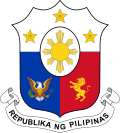| National Assembly | |||||
|---|---|---|---|---|---|
| |||||
 | |||||
| Overview | |||||
| Term | September 25, 1943 – February 2, 1944 | ||||
| President | Jose P. Laurel | ||||
| National Assembly | |||||
| Members | 108 | ||||
| Speaker | Benigno Aquino Sr. | ||||
| Floor leader | Francisco Zulueta | ||||
 |
|---|
The National Assembly was the legislature of the Second Philippine Republic from September 25, 1943, to February 2, 1944.
Contents
Half of the membership of the assembly consisted of provincial governors or city mayors acting in an ex officio capacity, while the other half were indirectly elected through local conventions of KALIBAPI members during the Japanese occupation of the Philippines. [1]